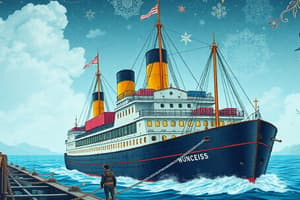Podcast
Questions and Answers
What was identified as the cause of the failure of the screws holding the glass frame?
What was identified as the cause of the failure of the screws holding the glass frame?
- The screws were overtightened during the initial installation.
- The screws were made from low-quality plastic.
- The screws had poor manufacturing quality. (correct)
- The glass frame was too heavy for the screws.
What action was taken to prevent future issues with screw overtightening?
What action was taken to prevent future issues with screw overtightening?
- Increased the torque specifications for all screws.
- Amended the procedure for using cabin deadlights in heavy weather. (correct)
- Replaced all screws with heavier materials.
- Installed a stronger glass frame.
What was the weight of the cargo that fell from the load during the near miss incident?
What was the weight of the cargo that fell from the load during the near miss incident?
- 500kg
- 400kg (correct)
- 300kg
- 200kg
What was the recommended max torque for brass screws according to maker advice?
What was the recommended max torque for brass screws according to maker advice?
What was found to be a contributing factor to the incident with the glass and glass frame?
What was found to be a contributing factor to the incident with the glass and glass frame?
Flashcards are hidden until you start studying
Study Notes
Brass Screws Incident
- Specified maximum torque for brass screws is 4N; minimal force causes overtightening.
- Investigation revealed 22 screws failed due to inadequate strength against wave force.
- Screws were poorly manufactured and had been overtightened during installation.
- Actions taken include checking other screws, overhauling scuttles, discussions with metallurgists, and amending cabin procedures.
Dropped Cargo Incident
- Cargo weighing over 400kg fell approximately 5m onto the vessel deck, nearly injuring crew.
- Two wooden crates were improperly secured to a pallet, allowing movement and instability.
- A gust of wind contributed to the fall as the crane turned during lifting operations.
- Recommendations include using only certified crew for lifting, visual inspections of cargo, and avoiding lifting wooden pallets.
Fast Rescue Boat (FRC) Launch Incident
- During FRC testing in dry dock, an improperly removed lashing line caused a collision with a railing.
- Hydraulic piping leaked, necessitating an immediate halt to the operation; no injuries occurred.
- Issues included a lack of pre-launch checks, clear procedures, and communication.
- Proposed actions focus on comprehensive risk assessments and training for crew members.
Wedge Failure Injury Incident
- A crew member injured after a wedge shattered while attempting to open a cargo hold hatch using a sledgehammer.
- The wedge remained lodged and broke instead of coming out, causing debris to injure the crew member.
- Emphasizes the need for thorough checks and consideration of safe practices before using heavy tools.
- Lessons include evaluating the swing direction and force required to prevent accidents.
Studying That Suits You
Use AI to generate personalized quizzes and flashcards to suit your learning preferences.




